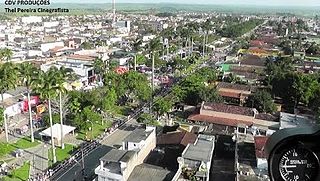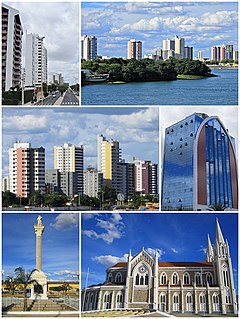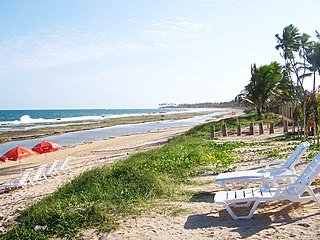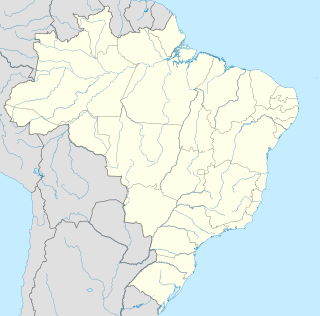
Recife is the fourth-largest urban area in Brazil with 4,054,866 inhabitants, the largest urban area of the North/Northeast Regions, and the capital and largest city of the state of Pernambuco in the northeast corner of South America. The population of the city proper was 1,625,583 in 2016. The first slave port in the Americas, Recife was founded in 1537, during the early Portuguese colonization of Brazil, as the main harbor of the Captaincy of Pernambuco, known for its large scale production of sugar cane. It was the former capital Mauritsstad of the 17th century colony of New Holland of Dutch Brazil, established by the Dutch West India Company. The city is located at the confluence of the Beberibe and Capibaribe rivers before they flow into the South Atlantic Ocean. It is a major port on the Atlantic. Its name is an allusion to the stone reefs that are present by the city's shores. The many rivers, small islands and over 50 bridges found in Recife city centre characterise its geography and led to the city being called the "Brazilian Venice". As of 2010, it is the capital city with the highest HDI in Northeast Brazil and second highest HDI in the entire North and Northeast Brazil.

Pernambuco is a state of Brazil, located in the Northeast region of the country. The state of Pernambuco also includes the archipelago Fernando de Noronha. With an estimated population of 9.2 million people in 2013, it is the seventh most populous state of Brazil, and is the sixth most densely populated and the 19th most extensive among the states and territories of the country. Its capital and largest city, Recife, is one of the most important economic and urban hubs in the country. As of 2013 estimates, Recife's metropolitan area is the fifth most populous in the country, and the largest urban agglomeration in Northeast Brazil.

Caruaru is a Brazilian municipality in the state of Pernambuco. The most populous city in the interior of the state, Caruaru is located in the microzone of Agreste and because of its cultural importance, it is nicknamed Capital do Agreste, Princesinha do Agreste, and Capital do Forró.

Goiana is a city in Brazil in the northeast of the state of Pernambuco, about 65 km north of the city of Recife.

Carpina is a city in Pernambuco, Brazil. Its economy is based on commerce and footwear industry. Its current mayor is Manoel Botafogo.

Petrolina is a city located in the southernmost point of the state of Pernambuco, in Brazil. The population was 349,145 in 2019 in a total area of 4,756.8 km², which makes it the largest and the most important municipality in the state by area.

Igarassu is a city in the Brazilian state of Pernambuco. It is the second oldest city of the country and is situated on the north coast of the metropolitan region of Recife, approximately 32 kilometres (20 mi). It stands as one of the earliest European settlements in Brazil and is the site of the oldest church in the country, the Church of Saints Cosme and Damião, built in 1535. Igarassu is home to numerous colonial-period historic structures. The historic center of the city was designated a national monument by the National Institute of Historic and Artistic Heritage (IPHAN) in 1972.

Cabo de Santo Agostinho is 35 km south of the city of Recife, Pernambuco, Brazil. Although the official Portuguese discovery of Brazil was by Pedro Álvares Cabral on April 21, 1500, some historians believe that Vicente Yáñez Pinzón already had set anchor in a bay in Cabo de Santo Agostinho on January 26, 1500, which he named Cabo de Santa María de la Consolación. It was incorporated as a town in 1811.

Araripina is a Brazilian municipality in the state of Pernambuco. Has an estimated population in 2009 of 79.877 inhabitants according with IBGE. Total area of 1.847,5 km2 and is located in the state mesoregion of Sertão, at 622 meters above the sea level and 683 km West from the state capital, Recife. The exploration of gypsum and calcarium is the base of the local economy and at the homonymous microregion.

Belo Jardim a Brazilian municipality in the state of Pernambuco. Has an estimated population in 2009 of 74.028. Total area of 647.7 km². It is located at 608 meters above the sea level and 182 km away from the state capital, Recife.

Ipojuca is a municipality in Pernambuco in eastern Brazil. As of 2009 the population according to IBGE was 75,512 and the per capita income (2007) was R$76.418 making it one of the country's highest. The settlement dates to 1560, but the official founding date is 1861 and the community was incorporated as a town in 1864. It is famous for its beaches such as Porto de Galinhas, Muro Alto, Maracaipe.

Itapissuma is a city in the state of Pernambuco, Brazil. It is integrated in the Recife metropolitan area with another 13 cities. Itapissuma has a total area of 74.25 square kilometers and had an estimated population of 24.406 inhabitants in 2009 according to the IBGE. The city has the best children's mortality rate in the metropolitan area and has also the second highest GDP per capita after Ipojuca.

Ouricuri is a city in the state of Pernambuco, Brazil. It is located in the mesoregion of Sertão Pernambucano. Ouricuri has a total area of 2,423 square kilometers and had an estimated population of 66,978 inhabitants in 2009 according to the IBGE.

Suape Port is a Brazilian International Port in the city of Ipojuca in the state of Pernambuco. The port is located inside the Recife metropolitan area, 40 km south of the city. Suape is a non-tidal port that services ships 365 days a year. It is one of the most important harbours and container terminals in the northeast of Brazil. It plays an important role in the economy of the state of Pernambuco. In the 21st century Suape became Pernambuco's main focus for development.

Ferreiros is a city located in the state of Pernambuco, Brazil, 118 km from Recife, capital of the state of Pernambuco, with an estimated population of 11,456 inhabitants.
Camutanga is a city located in the state of Pernambuco, Brazil. Located at 120 km from Recife, capital of the state of Pernambuco. Has an estimated population of 8.214 people and one of the strongest GDP per capita of Zona da mata Pernambucana.

Itambé is a city located in the state of Pernambuco, Brazil. Located at 99 km away from Recife, capital of the state of Pernambuco. Has an estimated population of 36.126 inhabitants.
Itaquitinga is a city located in the state of Pernambuco, Brazil. Located at 84 km away from Recife, capital of the state of Pernambuco. Has an estimated population of 15.507 inhabitants.
Condado is a city located in the state of Pernambuco, Brazil. Located at 69.3 km away from Recife, capital of the state of Pernambuco. Has an estimated population of 24.403 inhabitants.

Trindade is a city in the state of Pernambuco, Brazil. The population in 2009, according with IBGE was 26.250 inhabitants and the total area is 229.57 km².

















